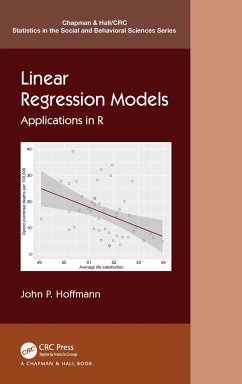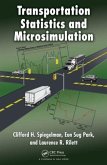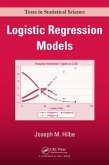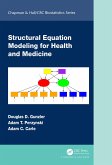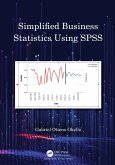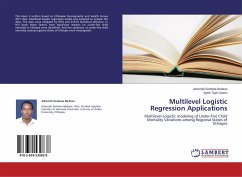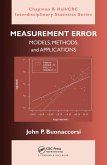- Gebundenes Buch
- Merkliste
- Auf die Merkliste
- Bewerten Bewerten
- Teilen
- Produkt teilen
- Produkterinnerung
- Produkterinnerung
This book includes chapters on specifying the correct linear regression model, adjusting for measurement error, understanding the effects of influential observations, and using multilevel data.
Andere Kunden interessierten sich auch für
![Transportation Statistics and Microsimulation Transportation Statistics and Microsimulation]() Clifford SpiegelmanTransportation Statistics and Microsimulation110,99 €
Clifford SpiegelmanTransportation Statistics and Microsimulation110,99 €![Logistic Regression Models Logistic Regression Models]() Joseph M. HilbeLogistic Regression Models192,99 €
Joseph M. HilbeLogistic Regression Models192,99 €![Structural Equation Modeling for Health and Medicine Structural Equation Modeling for Health and Medicine]() Douglas D. GunzlerStructural Equation Modeling for Health and Medicine148,99 €
Douglas D. GunzlerStructural Equation Modeling for Health and Medicine148,99 €![Simplified Business Statistics Using SPSS Simplified Business Statistics Using SPSS]() Gabriel Otieno OkelloSimplified Business Statistics Using SPSS167,99 €
Gabriel Otieno OkelloSimplified Business Statistics Using SPSS167,99 €![R Companion for Sampling R Companion for Sampling]() Yan LuR Companion for Sampling94,99 €
Yan LuR Companion for Sampling94,99 €![Multilevel Logistic Regression Applications Multilevel Logistic Regression Applications]() Ashenafi Senbeta BedaneMultilevel Logistic Regression Applications27,99 €
Ashenafi Senbeta BedaneMultilevel Logistic Regression Applications27,99 €![Measurement Error Measurement Error]() John P. BuonaccorsiMeasurement Error187,99 €
John P. BuonaccorsiMeasurement Error187,99 €-
-
-
This book includes chapters on specifying the correct linear regression model, adjusting for measurement error, understanding the effects of influential observations, and using multilevel data.
Produktdetails
- Produktdetails
- Verlag: Chapman and Hall/CRC
- Seitenzahl: 438
- Erscheinungstermin: 13. September 2021
- Englisch
- Abmessung: 240mm x 161mm x 28mm
- Gewicht: 819g
- ISBN-13: 9780367753689
- ISBN-10: 0367753685
- Artikelnr.: 62228809
- Herstellerkennzeichnung
- Libri GmbH
- Europaallee 1
- 36244 Bad Hersfeld
- gpsr@libri.de
- Verlag: Chapman and Hall/CRC
- Seitenzahl: 438
- Erscheinungstermin: 13. September 2021
- Englisch
- Abmessung: 240mm x 161mm x 28mm
- Gewicht: 819g
- ISBN-13: 9780367753689
- ISBN-10: 0367753685
- Artikelnr.: 62228809
- Herstellerkennzeichnung
- Libri GmbH
- Europaallee 1
- 36244 Bad Hersfeld
- gpsr@libri.de
John P. Hoffmann is a professor of sociology at Brigham Young University. He holds a PhD in Criminology from the State University of New York at Albany and a Masters of Public Health (MPH) from Emory University. He has worked at the U.S. Centers for Disease Control and Prevention (CDC) and the National Opinion Research Center (NORC) of the University of Chicago; and taught at Hokkaido University and the University of South Carolina. Hoffmann is the author of more than 100 journal articles and book chapters and 10 books on applied statistics, criminology, and the sociology of religion.
1. Introduction 2. Review of Elementary Statistical Concepts 3. Simple
Linear Regression Models 4. Multiple Linear Regression Models 5. The
ANOVA Table and Goodness-of-Fit Statistics 6. Comparing Linear Regression
Models 7. Indicator Variables in Linear Regression Models 8.
Independence 9. Homoscedasticity 10. Collinearity and Multicollinearity
11. Normality, Linearity, and Interaction Effects 12. Model Specification
13. Measurement Errors 14. Influential Observations: Leverage Points and
Outliers 15. Multilevel Linear Regression Models 16. A Brief Introduction
to Logistic Regression 17. Conclusions Appendix A: Data Management
Appendix B: Using Simulations to Examine Assumptions of Linear Regression
Models Appendix C: Formulas Appendix C: User-Written R Packages Employed
in Examples
Linear Regression Models 4. Multiple Linear Regression Models 5. The
ANOVA Table and Goodness-of-Fit Statistics 6. Comparing Linear Regression
Models 7. Indicator Variables in Linear Regression Models 8.
Independence 9. Homoscedasticity 10. Collinearity and Multicollinearity
11. Normality, Linearity, and Interaction Effects 12. Model Specification
13. Measurement Errors 14. Influential Observations: Leverage Points and
Outliers 15. Multilevel Linear Regression Models 16. A Brief Introduction
to Logistic Regression 17. Conclusions Appendix A: Data Management
Appendix B: Using Simulations to Examine Assumptions of Linear Regression
Models Appendix C: Formulas Appendix C: User-Written R Packages Employed
in Examples
1. Introduction
2. Review of Elementary Statistical Concepts
3. Simple Linear Regression Models
4. Multiple Linear Regression Models
5. The ANOVA Table and Goodness-of-Fit Statistics
6. Comparing Linear Regression Models
7. Indicator Variables in Linear Regression Models
8. Independence
9. Homoscedasticity
10. Collinearity and Multicollinearity
11. Normality, Linearity, and Interaction Effects
12. Model Specification
13. Measurement Errors
14. Influential Observations: Leverage Points and Outliers
15. Multilevel Linear Regression Models
16. A Brief Introduction to Logistic Regression
17. Conclusions
Appendix A: Data Management
Appendix B: Using Simulations to Examine Assumptions of Linear Regression Models
Appendix C: Formulas
Appendix C: User-Written R Packages Employed in Examples
2. Review of Elementary Statistical Concepts
3. Simple Linear Regression Models
4. Multiple Linear Regression Models
5. The ANOVA Table and Goodness-of-Fit Statistics
6. Comparing Linear Regression Models
7. Indicator Variables in Linear Regression Models
8. Independence
9. Homoscedasticity
10. Collinearity and Multicollinearity
11. Normality, Linearity, and Interaction Effects
12. Model Specification
13. Measurement Errors
14. Influential Observations: Leverage Points and Outliers
15. Multilevel Linear Regression Models
16. A Brief Introduction to Logistic Regression
17. Conclusions
Appendix A: Data Management
Appendix B: Using Simulations to Examine Assumptions of Linear Regression Models
Appendix C: Formulas
Appendix C: User-Written R Packages Employed in Examples
1. Introduction 2. Review of Elementary Statistical Concepts 3. Simple
Linear Regression Models 4. Multiple Linear Regression Models 5. The
ANOVA Table and Goodness-of-Fit Statistics 6. Comparing Linear Regression
Models 7. Indicator Variables in Linear Regression Models 8.
Independence 9. Homoscedasticity 10. Collinearity and Multicollinearity
11. Normality, Linearity, and Interaction Effects 12. Model Specification
13. Measurement Errors 14. Influential Observations: Leverage Points and
Outliers 15. Multilevel Linear Regression Models 16. A Brief Introduction
to Logistic Regression 17. Conclusions Appendix A: Data Management
Appendix B: Using Simulations to Examine Assumptions of Linear Regression
Models Appendix C: Formulas Appendix C: User-Written R Packages Employed
in Examples
Linear Regression Models 4. Multiple Linear Regression Models 5. The
ANOVA Table and Goodness-of-Fit Statistics 6. Comparing Linear Regression
Models 7. Indicator Variables in Linear Regression Models 8.
Independence 9. Homoscedasticity 10. Collinearity and Multicollinearity
11. Normality, Linearity, and Interaction Effects 12. Model Specification
13. Measurement Errors 14. Influential Observations: Leverage Points and
Outliers 15. Multilevel Linear Regression Models 16. A Brief Introduction
to Logistic Regression 17. Conclusions Appendix A: Data Management
Appendix B: Using Simulations to Examine Assumptions of Linear Regression
Models Appendix C: Formulas Appendix C: User-Written R Packages Employed
in Examples
1. Introduction
2. Review of Elementary Statistical Concepts
3. Simple Linear Regression Models
4. Multiple Linear Regression Models
5. The ANOVA Table and Goodness-of-Fit Statistics
6. Comparing Linear Regression Models
7. Indicator Variables in Linear Regression Models
8. Independence
9. Homoscedasticity
10. Collinearity and Multicollinearity
11. Normality, Linearity, and Interaction Effects
12. Model Specification
13. Measurement Errors
14. Influential Observations: Leverage Points and Outliers
15. Multilevel Linear Regression Models
16. A Brief Introduction to Logistic Regression
17. Conclusions
Appendix A: Data Management
Appendix B: Using Simulations to Examine Assumptions of Linear Regression Models
Appendix C: Formulas
Appendix C: User-Written R Packages Employed in Examples
2. Review of Elementary Statistical Concepts
3. Simple Linear Regression Models
4. Multiple Linear Regression Models
5. The ANOVA Table and Goodness-of-Fit Statistics
6. Comparing Linear Regression Models
7. Indicator Variables in Linear Regression Models
8. Independence
9. Homoscedasticity
10. Collinearity and Multicollinearity
11. Normality, Linearity, and Interaction Effects
12. Model Specification
13. Measurement Errors
14. Influential Observations: Leverage Points and Outliers
15. Multilevel Linear Regression Models
16. A Brief Introduction to Logistic Regression
17. Conclusions
Appendix A: Data Management
Appendix B: Using Simulations to Examine Assumptions of Linear Regression Models
Appendix C: Formulas
Appendix C: User-Written R Packages Employed in Examples

